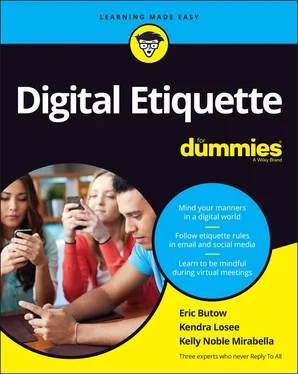Eric Butow - Digital Etiquette For Dummies
Здесь есть возможность читать онлайн «Eric Butow - Digital Etiquette For Dummies» — ознакомительный отрывок электронной книги совершенно бесплатно, а после прочтения отрывка купить полную версию. В некоторых случаях можно слушать аудио, скачать через торрент в формате fb2 и присутствует краткое содержание. Жанр: unrecognised, на английском языке. Описание произведения, (предисловие) а так же отзывы посетителей доступны на портале библиотеки ЛибКат.
- Название:Digital Etiquette For Dummies
- Автор:
- Жанр:
- Год:неизвестен
- ISBN:нет данных
- Рейтинг книги:5 / 5. Голосов: 1
-
Избранное:Добавить в избранное
- Отзывы:
-
Ваша оценка:
- 100
- 1
- 2
- 3
- 4
- 5
Digital Etiquette For Dummies: краткое содержание, описание и аннотация
Предлагаем к чтению аннотацию, описание, краткое содержание или предисловие (зависит от того, что написал сам автор книги «Digital Etiquette For Dummies»). Если вы не нашли необходимую информацию о книге — напишите в комментариях, мы постараемся отыскать её.
Digital Etiquette For Dummies,
Digital Etiquette For Dummies
Digital Etiquette For Dummies — читать онлайн ознакомительный отрывок
Ниже представлен текст книги, разбитый по страницам. Система сохранения места последней прочитанной страницы, позволяет с удобством читать онлайн бесплатно книгу «Digital Etiquette For Dummies», без необходимости каждый раз заново искать на чём Вы остановились. Поставьте закладку, и сможете в любой момент перейти на страницу, на которой закончили чтение.
Интервал:
Закладка:
Brexit may be a reality, but data protection knows no borders, and so it’s no surprise that UK laws are modeled closely on the GDPR. The people who put together the UK policy decided to make things easy and just refer to their policy as UK GDPR.
The Information Commissioner’s Office, or ICO, is an independent body that contains information about the UK GDPR for businesses and individuals. For businesses, that means you can't just learn what the UK GDPR requires; you also need to take a self-assessment test to see whether your business is ready to adhere to the UK GDPR — no matter whether you’re in the UK or you want to do business in the UK.
For consumers, this means you can learn what your rights are under the UK GDPR, including your rights to be informed, to get your data deleted, to limit how organizations use your data, and more.
All this information, as well as a complaint form, is available on the ICO at https://ico.org.uk , as shown in Figure 2-7.

FIGURE 2-7:The Information Commissioner’s Office website offers news, advice, and common topics.
Canada
Though Canada is a country that still recognizes the UK monarch as the head of state, Canada makes its own rules — including antispam laws. Canada is straightforward, as is its wont, and calls its antispam law Canada’s Anti-Spam Legislation (CASL).
The Canadian Radio-Television and Telecommunications website has a page about the CASL that you can find at https://crtc.gc.ca/eng/internet/anti.htm , as shown in Figure 2-8.
Like similar antispam laws, CASL regulates all electronic messages — including email and texts within, from, and to Canada — that organizations send with what the law calls commercial activity.

FIGURE 2-8:You can find plenty of helpful links and information on the CASL home page.
The website has not only a lot of frequently asked questions and other helpful links but also a list of five compliance tips to follow — including a phone number you can call to ask for help. (We haven’t called it ourselves, but we expect that you’ll talk to a real person because it’s Canada.)
Honoring Boundaries
The COVID-19 pandemic accelerated talk about setting boundaries in all communication, but especially with online communication. Health officials helped guide people in moderating their physical boundaries to keep themselves safe, such as by physically touching with a fist bump. Others suggest not touching at all because using the Vulcan hand salute from Star Trek as a greeting is clearly healthier (and hipper).
The most discussion about boundaries centered on understanding everyone’s mental boundaries, especially with the mental stress of many people forced to change their lives and daily structure. Though the boundaries we talk about in this section have no legal force (at least here in the US, where we are), understanding and setting boundaries are helpful goals if you want to avoid any legal misadventures.
You may have read in Chapter 1about how to communicate with people, and that’s fine. In this chapter, we review some of that material, in case you don’t want to go back (but you always can).
Then we talk about setting boundaries, talking with your team to set policies in your business that work for everyone (or at least reasonably so), and why you should consider centralizing your communication online. Finally, we talk about using the right medium for the message you want to send.
Communicating with people during work hours
There are plenty of rules, stated and not, that you should follow when communicating with your employees during work hours. This advice doesn’t change when you connect online just because people work in different parts of the country and/or the world or because pandemic safety requires that everyone work from home.
With that said, let’s quickly review the basics of communicating with people online:
Use face-to-face communication whenever possible, and that means to get together with an online chat app such as Zoom. That’s no substitute for meeting with people in person, but it still helps fulfill the human need to see the other person you’re talking with.
Listen and pay attention to what people are saying.
Make eye contact as much as possible to show you’re engaged.
Pay attention to nonverbal messages. Online, you can’t see all those messages someone else’s body is telling you, but you can still learn a lot by their facial movements and even body movements, like someone moving around in their chair when they’re uncomfortable.
Participate in the conversation. Everyone in the meeting needs to contribute if it has a chance of being effective.
Speak calmly and openly — you know, like a professional.
Acknowledge people’s time and thank them for talking with you.
So what, you ask? That’s basic stuff. But working online has also required a greater understanding about boundaries during work hours. After all, when someone works from home, their entire workday isn’t taken up by work. They have to manage their family (called the real job by some), go to appointments, and try to juggle the bowling ball, chainsaw, and dinner plates as best they can.
 Working remotely also makes it easier for people to violate someone else’s boundaries, no matter what role they have. We talk about how to call out boundary violations later in this chapter.
Working remotely also makes it easier for people to violate someone else’s boundaries, no matter what role they have. We talk about how to call out boundary violations later in this chapter.
Every employee and every manager is different, so you will experience policies created from your company’s unique priorities, expectations, and boundaries. Those include how you will communicate with one another, such as using Zoom for online meetings and using an app like Slack for project communication.
If you’re a manager who will be developing your online communication policies, you need to resolve several issues:
What the at-home job duties and responsibilities are
How you want to create work-from-home schedules
When and how you can contact people after work hours
Whether you want to give people the option of working on weekends and holidays
How often the communication policy needs to be changed and who’s responsible for reviews and changes
You may have guessed (correctly) that you need to bring your ideas to your managers and to your employees in order to craft an overall policy. That's best done in a meeting setting — maybe even more than one meeting — where you can finalize that policy. Be sure to come prepared to every meeting and communicate to your team that you expect them to do the same.
 If you want to find a remote job or you’re a manager who wants to hire remotely, one good resource is We Work Remotely (
If you want to find a remote job or you’re a manager who wants to hire remotely, one good resource is We Work Remotely ( https://weworkremotely.com ), shown in Figure 2-9. The site has not only remote job listings but also a guide to hiring remotely that you can apply to any industry. And you can post remote jobs on the site for $299.

FIGURE 2-9:The We Work Remotely website lists current remote jobs on the home page.
Читать дальшеИнтервал:
Закладка:
Похожие книги на «Digital Etiquette For Dummies»
Представляем Вашему вниманию похожие книги на «Digital Etiquette For Dummies» списком для выбора. Мы отобрали схожую по названию и смыслу литературу в надежде предоставить читателям больше вариантов отыскать новые, интересные, ещё непрочитанные произведения.
Обсуждение, отзывы о книге «Digital Etiquette For Dummies» и просто собственные мнения читателей. Оставьте ваши комментарии, напишите, что Вы думаете о произведении, его смысле или главных героях. Укажите что конкретно понравилось, а что нет, и почему Вы так считаете.












